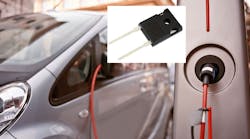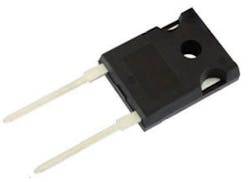Six new FRED Pt Gen 5 1200-V Hyperfast and Ultrafast rectifiers developed by Vishay Intertechnology deliver what the company claims is the best conduction and switching loss tradeoff for devices in their class. The 30- and 60-A rectifiers are specifically designed to improve the efficiency of power factor correction (PFC) and output rectification stages of electric-vehicle/hybrid electric-vehicle battery-charging stations, as well as the booster stage of solar inverters and UPS applications. Designed to increase the efficiency of high-frequency converters as well as hard- and soft-switched or resonant designs, these devices are matched to operate with MOSFETs or high-speed IGBTs.
The Hyperfast and Ultrafast rectifiers are available in TO-247AD 2L and TO-220AC 2L packages. (Source: Vishay)
According to Vishay, the rectifiers offer up to 10% lower losses versus competing silicon solutions, cutting the efficiency gap with silicon-carbide (SiC) diodes in half. In turn, they would provide a cost-effective alternative for applications with frequencies in the range of 50 kHz.
SiC is a wide-bandgap material. Wide-bandgap (WBG) semiconductors permit devices to operate at higher voltages, frequencies, and temperatures than conventional silicon. What’s more, switching and conduction losses are lower. Consequently, WBG technology becomes an attractive option for power electronics, particularly for use in electric vehicles. Vishay’s new rectifiers are aimed at reducing the performance advantage of SiCs, which are more difficult to mass-produce and thus carry a higher cost.
Both of the new 30- and 60-A rectifiers are available in the TO-247L package, and in X-type Hyperfast and H-type Ultrafast speed classes (see table). The 30 A devices also come in the TO-220AC.
X-type rectifiers offer the advantage of lower QRR, (recovered charge) while H-type devices feature lower forward voltage (VF). Both offer the same forward voltage as competing solutions, according to Vishay, while delivering up to 40 % lower switching losses and QRR, respectively. Operating temperature ranges up to +175°C.
Samples and production quantities of the new FRED Pt rectifiers are available now, with lead times of 18 weeks for larger orders.



